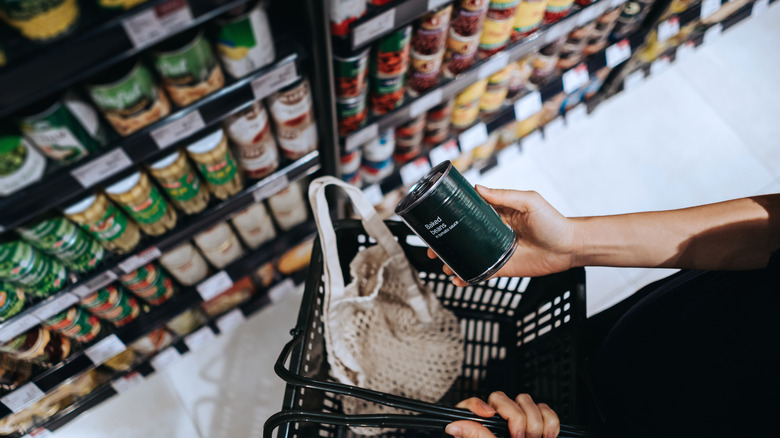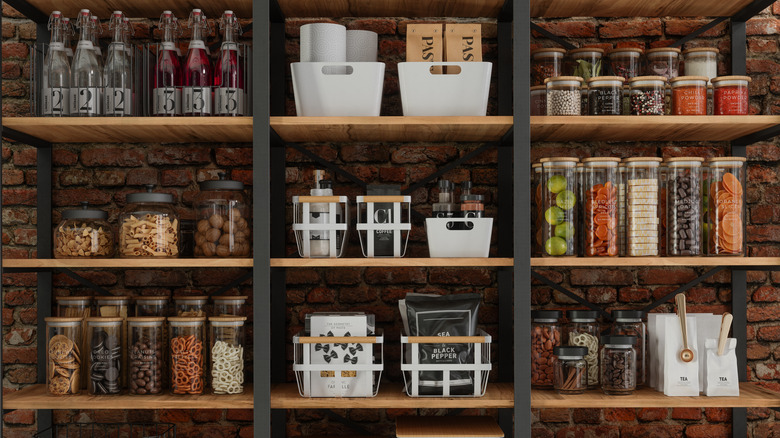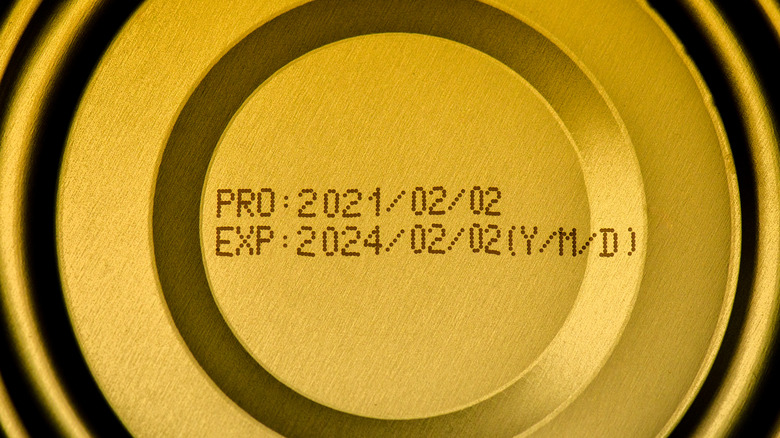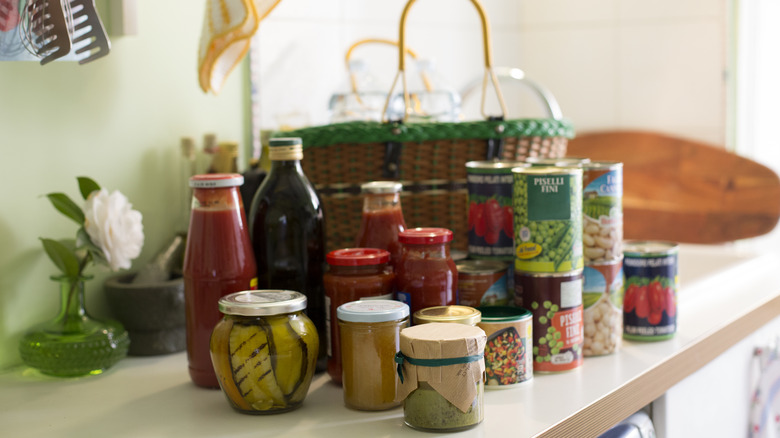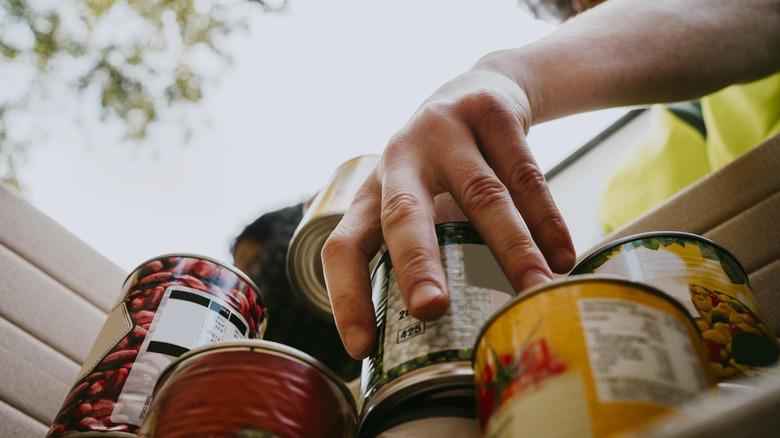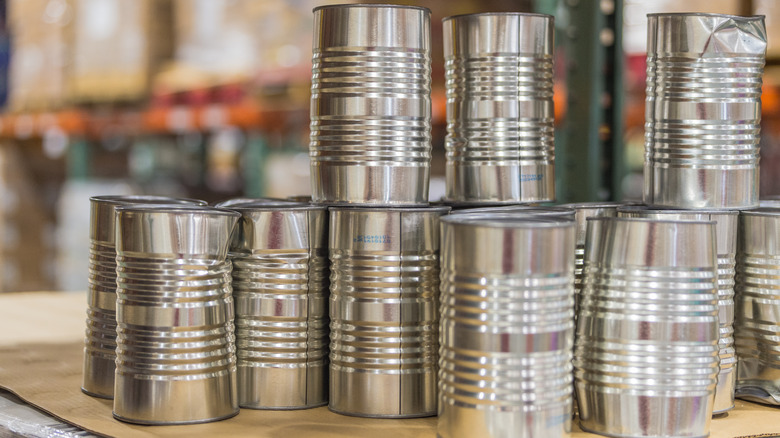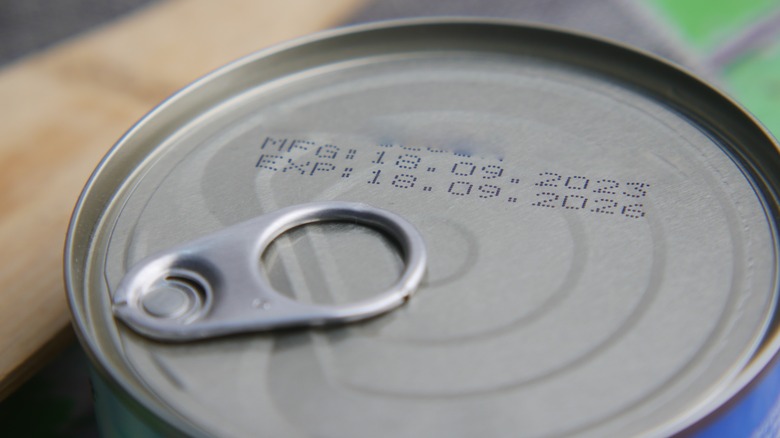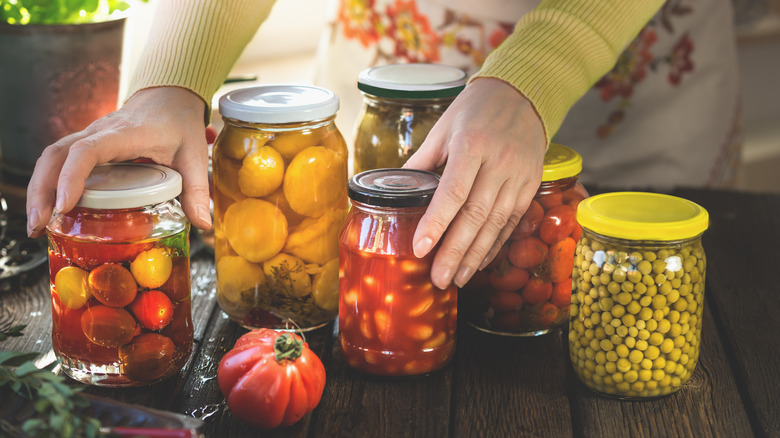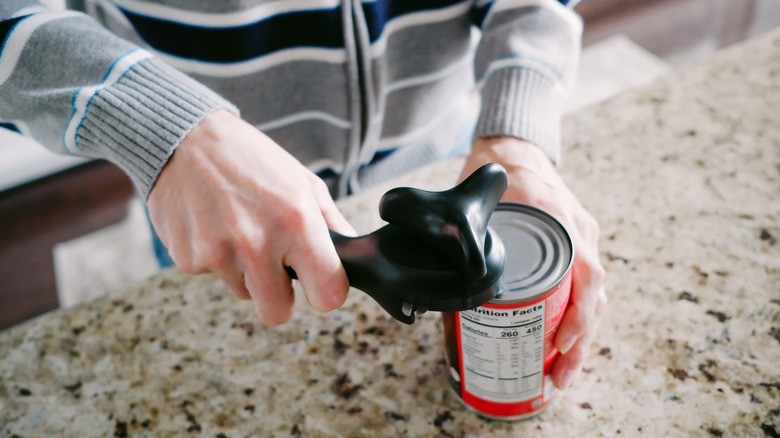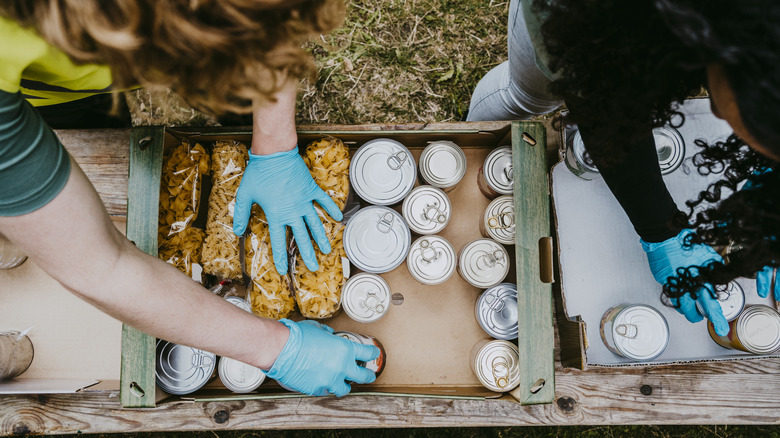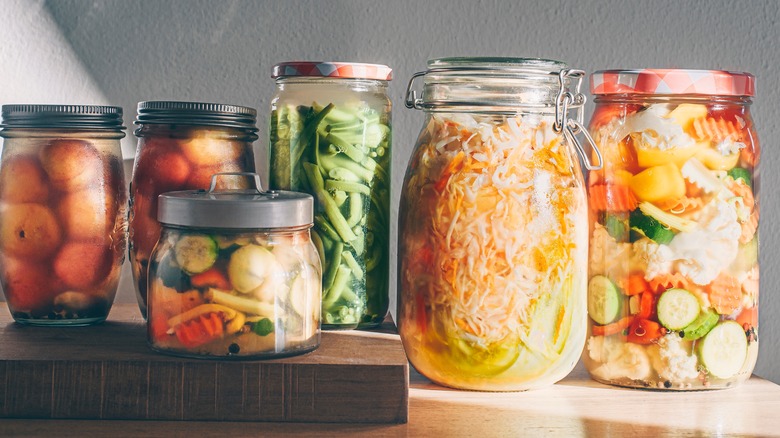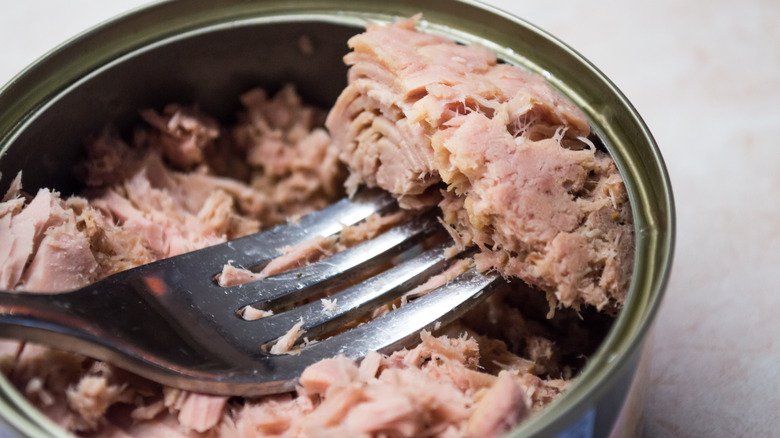Avoid These Mistakes When Storing Canned Goods, According To An Expert
The canned food market is a wide-ranging realm of soups, vegetables, meats, and more that are accessible, affordable, and nonperishable. As of 2024, the United States canned food market rests at a sizable $89 billion, proving one thing for sure — Americans love canned foods. Canned products are easy to consume and often save us from having to do miscellaneous prepping tasks like chopping or peeling fruits and vegetables.
Some people can their own foods to have ready-to-use home-made ingredients. Home-canning is a process in which various foods are placed in jars and heated in order to eliminate bacteria that would otherwise cause spoilage. Home-canning is perfect for canning produce from a farmers' market or personal garden, and many people have taken up the hobby to curate a home pantry that is full of less-processed food items. Even more, consumers end up with easy-to-grab products to make a quick meal on a busy evening.
Unfortunately, many people are unaware of the proper storage strategies for home-canned foods and store-bought cans alike. Storing canned items incorrectly can result in bacteria growth, which could lead to food-borne illnesses. Factors such as temperature, sunlight, and even the number of cans stacked on top of each other can affect how well a canned food is preserved, and knowing what to avoid will help you to store your canned items properly.
Not storing in the right environment
You might just store all of your canned items in the same cabinet in your home kitchen, putting little thought into how the temperature, and even the lighting, will affect the jar. Food items stored in tin or metal cans — or jars with metal lids — should be stored in cool, dark, and dry places. According to Amy Johnston, regional extension educator in food safety at the University of Minnesota Extension, "The metal has the potential to rust if exposed to moisture. The rust can contaminate food when the can or jar is opened." Thus, these types of cans may be stored in a pantry or cabinet.
Foods in glass or plastic containers could be exposed to too much heat if left in sunny areas of your kitchen, which could lead to color changes and spoilage. Johnston says, "Any canned food stored in hot environments (above room temperature) have the potential to spoil," so room temperature is ideal for preserving canned food items. Further, if you are home-canning, it is also helpful for preservation to put labels on your canned foods to note the date the food was canned so you can use it while it is still in peak freshness.
Waiting too long to use canned items
Although the best canned foods are certainly meant to last longer than fresh produce, there are many misconceptions of just how long these items are meant to be in the cabinet. Amy Johnston, the regional extension educator in food safety at the University of Minnesota Extension, says you should "make sure to label [cans] with the food name and date with the date prepared so you can keep track of time. Home-canned foods should be used within 12-18 months of canning." Food canned by a manufacturer can usually be stored for much longer because manufacturers often have the manpower and resources to provide in-depth quality controls on their canned items to ensure maximum preservation.
Once a can is open — store-bought or home-canned — it's also important to use the remaining portions within three to four days, according to Johnston. Even more, canned items can suffer wear and tear when stored for a long time, so if you're not using an item soon after purchasing, it's important to pay attention to the integrity of the seal — as long as the seal is properly intact, the can is still viable for use.
Not canning produce at its peak freshness
If you are trying your hand at home-canning foods, it is always best to preserve produce while it is the most fresh, and when it is in season, notes Amy Johnston, food safety expert at the University of Minnesota Extension. Fresh produce is essential in a diet because of the nutrients it contains, and storing and using fresh fruits and vegetables at their peak is essential to having canned items that aren't processed but are rather fresh and delicious.
You should use the pressure canning method for low-acid foods like asparagus, peas, pumpkin, or mushrooms. The pressure canning method, in this case, increases the temperature of the food to decrease the chance of foodborne illnesses, something that the boiling water bath method could not do well for low-acid produce. On the other hand, naturally acidic fruits like apples or berries can be canned using either the pressure canning or boiling water bath method, with a difference in the length of the process for each method.
Despite the food's natural acidity, some fruits — like Asian pears or grapes — need a little bit more acid added in to make the canning process more sustainable. This is another step to take to ensure the produce's maximum freshness prior to canning.
Canning foods that shouldn't be canned
Not all food products are meant to be canned. According to Amy Johnston, food safety expert, "There are some foods that do not have research-based recipes for home-canning. These foods should not be canned. Some examples are white-flesh peaches and nectarines, broccoli, and radishes." When exposed to a lot of heat, broccoli becomes soft and mushy, which is not the ideal texture for cooking broccoli. Thus, through the pressure canning process that one would use for broccoli, it would be exposed to too much heat to maintain its integrity, and so would not be worth keeping. In this way, broccoli is what is called a tender food product, meaning the canning process would affect the quality of the food item.
Because of the lack of research behind canning white-fleshed peaches, there is not a guarantee that the pressure canning process normally used for low-acid foods will effectively get rid of the bacteria. Instead of canning these kinds of food, you can freeze them, or simply prepare them fresh.
Also, if you've ever wondered why pasta sauce is canned and pasta noodles are not, this is why: If pasta noodles were to be canned, the starch in the pasta would interfere with the heat during the canning process and lead to a development of bacteria. The same is true for rice, which is why it is best to keep cans of pasta sauce or beans around for your starch-based sides.
Ignoring dents in the can
Earlier, I mentioned the wear and tear that can affect the integrity of your cans and therefore affect the rate at which the canned food could spoil. Sometimes, at the supermarket, you may see a dented can and push it to the side and grab the next intact one — while that act might seem unnecessary, it actually may save you from being at-risk for foodborne illnesses. Sometimes dents in a can may cause small leaks, cracks, or openings, which means the food inside is exposed to the environment and no longer at its peak freshness.
Similarly, as far as storing canned items, stacking too many cans on top of one another could ruin the integrity of the seals as it puts more weight on them, possibly bending the metal and ruining the seal. It's best to avoid stacking more than two cans on top of each other, and you should never stack anything heavy on any of your canned foods.
Not paying attention to the expiration dates
Who can blame us? There are so many types of expiration dates, they can be confusing — best by, sell by, use by, etc. It can be hard to know what they all mean and how to properly adhere to them. But, alas, it is important to know the difference between these dates to know when you should use your canned items. Especially because product dating is not federally required, which means that stores are allowed to sell some items beyond the date of their expiration, a consumer must pay extra heed to their cans' expiration dates.
A "sell by" date on a canned item indicates how long the store should have the product displayed on sale, and it is best to purchase the product before this date in order to use it during its peak quality time. A "use by" date is stamped by the manufacturer of the product and indicates the last date the product will be of utmost quality — you should enjoy the product prior to that date. Finally, a "best if used by" date is a nifty expiration date that indicates when the product will have the best flavors and quality by; this one is not a safety date, but it's convenient.
Forgetting to remove the ring from the lid of the jar
Here's another home-canning tip that is crucial to preventing bacteria growth in your jars. In most jar lids, there are plastic rings that line the inside of the lid. These rings need to be removed during the home-canning process to ensure that you are aware of any spoilage in the jar. The initial purpose of these rings is to hold the lid in place during processing, but once the cans are cooled and sealed, the rings can be removed so that any bacteria growth that occurs inside the jar will pop the lid open on its own dude to gasses being released by the bacteria — it's a built-in quality check, and it will alert you if something goes wrong with your canned foods.
Removing the rings isn't wasteful, either. The rings can be washed and stored in a plastic bag to maintain their quality, and they can be used for other canning projects, which will give you more rings for future cans!
Not moving leftover portions into a different container
If, after you crack open a canned good, you are not going to use the entire contents in one go, it is better to move the leftovers into a different storage container to properly preserve them, rather than leaving them in an open can. You can store unused portions of the canned food in a glass or plastic container and refrigerate them to maximize their freshness.
If you must store your canned items in their canned containers, be mindful of how long the food has before expiring. Open cans of fish or seafood tend to spoil in a couple days, whereas open cans of tomato sauce could last for up to five days. It all depends on the types of canned food you purchase. Regardless, storing leftover canned portions in an airtight container will limit the amount of contact the food has with the air, and therefore will avoid any changes in flavor and texture.
Ignoring the first in, first out rule
Some rules are meant to be broken, and some rules simply aren't. The "first in, first out" rule is one meant to be followed to a tee, but this often gets lost in translation. Because canned foods have far-off expiration dates, some consumers may think it's okay to use their canned items in any order, as long as it is before that date.
Unfortunately, this is not the best plan. The "first in, first out" rule means that if you have multiple cans of the same food, you should use the first can you purchased, followed by the next can you purchased, and so on. Sell by dates indicate a fairly limited amount of time, post-purchase, the product will be at its peak quality. So, you should always use cans in the purchase order to ensure you're getting the best flavors out of your canned foods. The first can in is the first can used – first in, first out.
An easy way to keep track of this is to rotate your canned items when you grocery shop. If you buy extra cans of the same product, pull the cans already in your cabinet to the front, and stack the new cans behind the older cans. This way, when you open the pantry, you will see the older cans, and you won't have to remember which one to use first.
Not considering home-canning
Since the start of the pandemic, home canning has become a more popular hobby for people who love to be in their kitchens. Preserving fruits and vegetables for a longer time means fewer trips to the grocery store, as your groceries will last a bit longer. Home canning can also prevent food waste since fresh produce from a farmers' market can be canned and preserved for longer than it would last in the fridge.
The method you choose to home-can your foods depends on the acidity of the food item because the method needs to effectively reduce the risk of foodborne illnesses. For example, fruits and pickled vegetables are high-acid foods — these foods should be canned using the boiling water method, in which the jars are covered in boiling water to seal the can. The other two methods are the pressure canning method (for low-acid foods like meats and seafood) and the atmospheric steam canning method (for naturally acidic foods like preserves).
Home-canning your food products allows you to store fresher food items that usually contain a lot of water and decrease their chance of spoiling quickly. In doing this, your canned foods will last longer, saving you trips to the grocery store or farmers' market and lessening the food waste you contribute to the world.
Failing to move the item out of storage
Just because a canned item starts its life on a shelf, doesn't mean that is where it should stay forever. For some canned foods, it is helpful to store them in the fridge temporarily before enjoying the can's contents, as this will create a more enjoyable eating experience. This tip is specifically helpful for canned tuna, the market of which consistently grows toward becoming one of the most enjoyed canned foods in the United States. Typically stored in the pantry, a can of tuna can benefit from being moved to the fridge for around 15 minutes before serving.
Refrigerating the tuna for this amount of time will help make the tuna salad more salad-like — a salad can taste odd if eaten at room temperature. If remembering to refrigerate the tuna feels like too big a feat during a busy work-from-home day, you could also store canned tuna in the refrigerator to begin with. Plus, this storage process may even make the tuna last longer, since the cold temperature in the fridge prevents bacteria from developing in the can.
